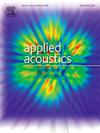水下声学中的柔性充气结构:散射实验
IF 3.4
2区 物理与天体物理
Q1 ACOUSTICS
引用次数: 0
摘要
水下人工声结构可以模拟复杂目标的回波特性,达到水声欺骗或干扰的效果。本文将被动水声结构的形态扩展到柔性充气设计,提出了一系列可折叠、可展开的柔性结构,用柔性膜代替刚性反射面。柔性充气结构具有可折叠存储、易于充气和部署、轻量化节能等优点,从而推动了人工结构在水声散射调制中的工程应用。设计并制造了一种水下定深悬停充气装置,实现了柔性结构在水下的储存和发射后在水中保持定深悬停状态。对具有代表性的柔性充气结构圆柱形和板状管束、多单元角反射器及其拓扑结构进行了声散射实验。获得了柔性充气结构的单稳态回波,揭示了目标强度随频率和空间方向的变化,以及统计方向特征。利用柔性充气角反射器组合来模拟复杂水下目标回波高光的水平方向分布。结果表明,柔性结构的声散射特性可用于模拟水下目标回波的高光结构,取得了较好的水下目标回波仿真效果。这些结构也可用于水声干扰器的设计,为水声模拟器或干扰器的应用提供支撑。未来还可以探索更灵活的充气结构。本文章由计算机程序翻译,如有差异,请以英文原文为准。
Flexible inflatable structures in underwater acoustics: Scattering experiments
Underwater artificial acoustic structures can be used to simulate the echo characteristics of complex targets, achieving the effects of underwater acoustic deception or interference. This paper extends the morphology of passive underwater acoustic structures to flexible inflatable designs and proposes a series of foldable and deployable flexible structures, replacing rigid reflective surfaces with flexible membranes. Flexible inflatable structures offer advantages such as foldability for storage, ease of inflation and deployment, and lightweight energy efficiency, thereby advancing the engineering applications of artificial structures in underwater acoustic scattering modulation. An underwater constant − depth hovering inflatable device was designed and fabricated to enable the underwater storage of flexible structures and maintain a constant − depth hovering state in water after launch. Acoustic scattering experiments were conducted on cylindrical and plate-like tube bundles, multi-cell corner reflectors, and their topological configurations, which serve as representative flexible inflatable structures. Monostatic echoes were obtained for the flexible inflatable structures, revealing the variations in target strength with respect to frequency and spatial orientation, and the statistical directional characteristics. A combination of flexible inflatable corner reflectors was utilized to simulate the horizontal directional distribution of echo highlights from complex underwater targets. The results show that the acoustic scattering characteristics of flexible structures can be used to simulate the highlight structure of underwater target echoes, achieving a good simulation effect of underwater target echoes. These structures can also be used in the design of underwater acoustic jammers, providing support for the application of underwater acoustic simulators or jammers. More flexible inflatable structures can be explored in the future.
求助全文
通过发布文献求助,成功后即可免费获取论文全文。
去求助
来源期刊

Applied Acoustics
物理-声学
CiteScore
7.40
自引率
11.80%
发文量
618
审稿时长
7.5 months
期刊介绍:
Since its launch in 1968, Applied Acoustics has been publishing high quality research papers providing state-of-the-art coverage of research findings for engineers and scientists involved in applications of acoustics in the widest sense.
Applied Acoustics looks not only at recent developments in the understanding of acoustics but also at ways of exploiting that understanding. The Journal aims to encourage the exchange of practical experience through publication and in so doing creates a fund of technological information that can be used for solving related problems. The presentation of information in graphical or tabular form is especially encouraged. If a report of a mathematical development is a necessary part of a paper it is important to ensure that it is there only as an integral part of a practical solution to a problem and is supported by data. Applied Acoustics encourages the exchange of practical experience in the following ways: • Complete Papers • Short Technical Notes • Review Articles; and thereby provides a wealth of technological information that can be used to solve related problems.
Manuscripts that address all fields of applications of acoustics ranging from medicine and NDT to the environment and buildings are welcome.
 求助内容:
求助内容: 应助结果提醒方式:
应助结果提醒方式:


